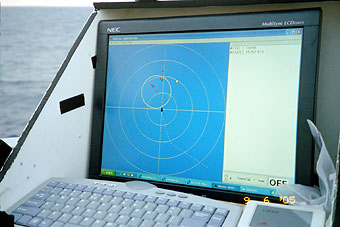

 | |||||||
|
|
Journals 2005/2006Maureen Barrett
August 23, 2005 I woke this morning to a page over the intercom system calling one of the mammal observers to the flying bridge. We were not on effort yet, but one of the bird watchers, Scott Mills, spotted the blows. He immediately contacted the bridge to page the mammal observers. Sperm whales were in the area, and the team decided to launch the small boat. This will allow the observers to get better photographs and possibly biopsy the animals. The zodiac was deployed within 20 minutes and heading toward the whales. On the ship, the rest of us continued to watch and record the position of the whales. It was estimated that we had come across a group of 15-20 sperm whales, Physeter macrocephalus. The sperm whale's scientific name, macrocephalus, is derived from Greek for "big head." Their bushy blow angles forward and left and comes from the front of the head. There were moments when the zodiac was out of view, even using the big eyes. The weather conditions were not the greatest. It was cloudy and a little rainy, so our visibility wasn't the greatest. The small boat managed to get a few shots off with the crossbow to get a biopsy, but to no avail. However, Cornelia Oedekoven and Anne Douglas managed to get some great photographs. I hope I get an opportunity to go out in the zodiac! After getting back to our trackline and going on effort, we ran into another group of sperm whales. How lucky can we be?! All of the mammal observers were called to the flying bridge to conduct a 90-minute sperm whale count. Sperm whales can dive for up to 40 minutes, so if we watch and wait for 90 minutes, we should be able to count all the whales in the group. We went off effort, and everyone watched for blows, breaching, and fluking. The data collected was immediately entered into computer, and all of the mammal observers kept track of whales. But you have to keep in mind that all of the whales are not necessarily right next to one another. They are in small groups at different angles and at different distances. Each observer watches one of the small clusters, keeping the recorder informed of what the whales are doing. Each small group is plotted on the computer screen and given a letter. The screen was littered with red dots indicating group sightings. After 90-minutes, it was estimated that we had just watched over fifty sperm whales going about their business in the open ocean!
A few hours later... |
||||||
